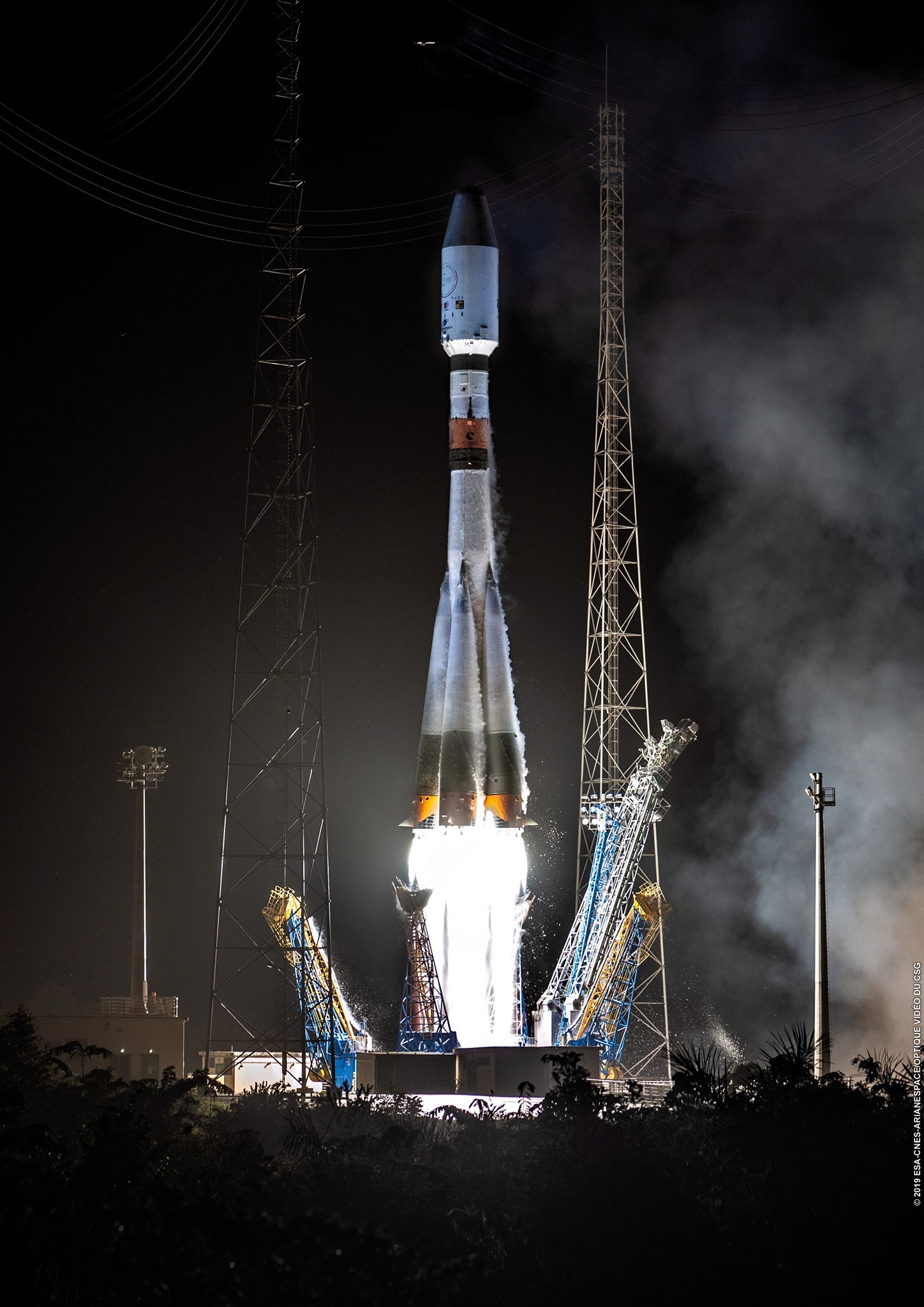Launch & Operations - CHEOPS
Launch & Operations
A succesfull Launch in December 2019
CHEOPS was launched on a Soyuz rocket operated by Arianespace from Europe's spaceport in Kourou on 18 December 2019 at 05:54 local time (08:54 GMT/UTC). It shared the rocket with the Italian Space Agency's Cosmo-SkyMed Second Generation satellite, together with three cubestas (OPS-SAT, EyeSat, and ANGELS). The satellites separated into their own orbits soon after ascent, with CHEOPS going into a low-Earth orbit at an altitude of 700 km and a Local Time of the Ascending Node (LTAN) of 6:00 At this altitude the orbital period of the satellite is just under 99 minutes.

A unique Operations ConcePT
Both the CHEOPS Ground Segment (GS) and the CHEOPS operational concept reflect the fast-track and low-cost nature of the mission, and follow two basic principles: 1) maximum reuse of existing infrastructure and operational tools, 2) high levels of both on-board autonomy and automation in the operations, in order to minimize the required manpower.
The CHEOPS GS is under the responsibility of the CHEOPS Mission Consortium (CMC), and comprises:
- the Mission Operations Centre (MOC), which is located at INTA in Torrejón de Ardoz, near Madrid (ES);
- the Science Operations Centre (SOC), which is located at University of Geneva (CH);
- Ground Stations (G/S) at Torrejón de Ardoz and Villafranca (ES). Ground stations located in Kiruna (Sweden) and in Troll (Antartcic), were also used during Launch and Early Orbit Phase (LEOP).
Launch and Early Orbit Phase (LEOP) & In-Orbit Commissioning (IOC)
The Kiruna G/S was used during LEOP to complement the Torrejon and Villafranca stations, providing additional passes (typically up to 10 per day) and enabling an earlier than otherwise possible acquisition of the spacecraft after the separation from the launcher. The duration of the LEOP was 4 days, leaving the spacecraft safely in the nominal operational orbit. In-Orbit Commissioning (IOC) started at the beginning of January 2020 and concluded with a succesful IOC Review (IOCR) on 24 March 2020, marking the end of the commissioning phase and start of routine science operations.
Mission Operations Centre (MOC)
The MOC is responsible for all mission operations, including LEOP and commissioning. The CHEOPS operational concept does not place stringent requirements on orbit control and, as a result, flight dynamics activities are minimal: in particular, no orbit maintenance manoeuvres were required after the initial launcher dispersion correction manoeuvre performed in LEOP, with the Local Transit of the Ascending Node remaining within the allowed range for the nominal duration of the mission. The orbit determination requirements can be fulfilled via Two Line Elements (TLE) available from NORAD/JSpOC. Doppler measurements will be used as a backup and to improve the orbit determination accuracy if needed. The satellite does not have a GPS receiver on-board, and so both the state vector and the On-Board Computer to Universal Coordinated time (OBC-UTC) time correlation coefficients will be computed on ground and uplinked to the spacecraft. The MOC operate typically from 9:00 - 17:00 CET/CEST on a 5 days-per-week basis during nominal operations.
Science Operations Centre (SOC)
The SOC is responsible for mission planning (tool provided by Deimos Engenharia (PT)), and typically produces a weekly activity plan, which includes all platform activities and sequences of inertial pointing directions and associated instrument parameters for each observation. The activity plan is then sent to the MOC, where a check is made to ensure that no critical spacecraft constraints are violated, and the plan is converted to telecommands and uplinked to the spacecraft for execution in the Mission Timeline (MTL). All science data is processed at the SOC using an automated data reduction pipeline and available to the Community via the Mission Archive hosted at the SOC. Data access and download are restricted to the PI of the observing programme to which the data belongs during the appropriate propriertary periods, as specified in the CHEOPS Science Management Plan (SMP). The SOC operate typically from 9:00 - 17:00 CET/CEST on a 5 days-per-week basis during nominal operations.
Routine Operations & Automation
The sequence of ground passes includes 5 to 6 daily passes over the G/S of Torrejon (or Villafranca, since the MOC plans to use both of them depending on their availability). Each pass has a duration of 7 to 10 minutes, with 2 to 3 of these passes taking place in the early morning (around 7:00 local time) and 2 to 3 passes in the early evening (around 8:00 local time). All passes are used to downlink the spacecraft telemetry at a fixed downlink rate of 1143 Kbps, which is compliant with the daily science and instrument housekeeping data generation of 1.2 Gb. Typically, one pass per week is used to uplink the activity plan to the satellite MTL. A high degree of automation has been implemented in the Mission Control System (MCS) and the MOC, so that nominally only the uplink passes will require the presence of the operator.
Curious to learn more?
Further details on the CHEOPS spacecraft can be found at CHEOPS Consortium Mission website (http://cheops.unibe.ch) and in the references at this link.
- Removed a total of (1) style text-align:center;
This website was last updated on 25 March 2025.








































 Sign in
Sign in
 Science & Technology
Science & Technology